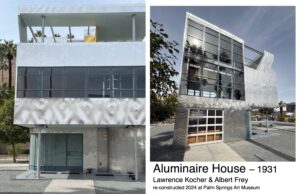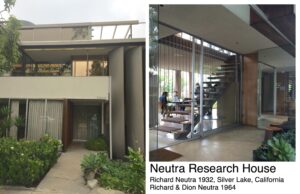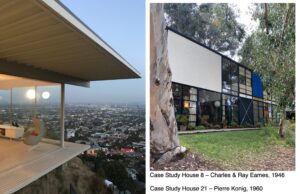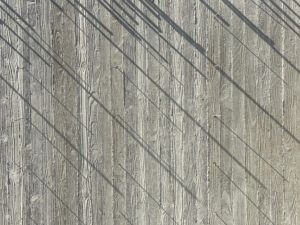For a successful technology, reality must take precedence over public relations, for Nature cannot be fooled.
~Richard Feynman
DTS PROJECT TECHNOLOGY NARRATIVE
The DTS Project House integrates well tested and state-of-the-art technology into every aspect of the project. Technology impacts the design process and dialogue among architect, client, and consultants. Technology makes the design intent possible and makes glamorous design sustainable. Technology makes enhanced operation, monitoring, and managing of the house possible with minimal effort. And most importantly, technology gives the DTS Project House its architectural character and allows one to experience the most fundamental and primal aspects of living in the house and on the property.
DTS Project House
The DTS Project House is conceived in the spirit and linage of projects like Kocher and Frey’s Aluminaire House, Richard Neutra’s VDL House, and the Art + Architecture’s Case Study Program. The architectural agenda includes demonstrating the integration of the most significant current technology while also simultaneously looking to history and to the future. The DTS Project House attempts to conserve meaningful technologies perfected over time and provide for the integration of future innovations. It proposes to show how technology can be an integral and significant aspect of sustainable architecture without overwhelming the architecture. Projects like Diller, Scofidio & Renfro’s Slow House of 1991 and Phantom House of 2007 and Hariri and Hariri’s Digital House of 1999 for MOMA’s Unprivate House Exhibition are among projects looked at for how Architects have proposed technology and architecture might relate to larger societal issues.



The DTS Project House proposes a life integrating technology and aesthetic experience – the integration of science and art. The DTS Project House is intended to model an attitude and process that integrates technology as a significant and vital aspect of an architectural aesthetic, but it does not intend to serve as a model for a particular aesthetic. The DTS Project House is equally house (the building) and project (the process).
The purpose of technology is to make the dream a fact…The end is to make the Earth a garden, Paradise; to make the mountain speak.
~ Arthur DrexlerDesign Process and Documentation
Like in the building itself, mills studio and the Owners have used the most current digital and virtual technologies simultaneously with the analogue and physical world to conduct and document the design process, and evaluate the design. Drone technology was used to document both the macro and micro aspects of the site and neighborhood context along with physically walking up and down the contours of the site and neighborhood streets. The DTS Project House was chiefly designed in 3D models with 2D construction documents generated from the models. The design was presented and evaluated using fly throughs of multiple 3D models, a myriad of focused screen shots of 3D models, and renderings looking at materials in their architectural context. BIMx models were generated for the client’s continual contemplation. But equally important, planning strategies, design concepts, and materials were presented and evaluated with real world examples through field trips, images, and samples which are now more easily facilitated through technology.
The DTS Project House exploits the opportunities offered by many significant technologies that we now take for granted, such as file sharing sites like Box.net, real time communication sites, and video conferencing sites. These and similar technologies allowed the design process to consider and integrate the information and input generated by the efforts of an almost unlimited number of disparate specialists located throughout the world.
Construction Process and Documentation
The same technologies that have dramatically enhanced the design process have also enhanced the construction process. The ability to simultaneously and in real time gain the input of multiple consultants, sub-contractors, vendors, fabricators, and craftsmen remote from the site allows for the integrated approach necessary to build the DTS Project House. The construction process is managed and documented with the use of POE and wireless IP Cameras mounted on and off site. Various applications like Spyware provide all interested parties access to the cameras and their data on devices from cell phones to desk top computers. mills studio and the construction are able to benefit from the real time input of consultants and contractors and parties remote from the site are able to benefit from real time observation of the construction. Drone photography documents major milestones in the construction process.
Research Program
mills studio and the Owner’s engaged in a continuous program of research during the design and construction process. The research program documented the best examples of relevant existing technologies; document current state-of-the-art technologies; and document the trends predicting future technological innovations. mills studio expanded upon its architectural agenda with a detailed criteria for evaluating the results of specific research so that the information gathered was actionable. No matter how seductive, the technology must further the architectural agenda and further it better than any other option and would simultaneously address multiple project intentions.
mills studio and the Owners took field trips to existing projects to document the relevance of existing technologies to the DTS Project House. These included a visit to Herzog and de Meuron’s Dominus Winery to experience the pros and cons of rock filled gabions. mills studio developed an extensive itinerary for visiting and documenting a wide variety of existing technology throughout the United States including exposed concrete and Apple Stores to document the latest in glass technology and glass fittings.
mills studio and the Owners attended numerous general building and product shows throughout the United States and specialized shows for particular categories of technology, such as CEDIA, The World of Concrete, and LightFair International. The Owners also attended technology manufacturer’s product launches, such as Elon Musk’s announcement of Tesla’s photovoltaic roof tiles at Universal Studios. These activities kept us aware of the myriad of options that current technological innovations offer and the areas of life that future innovations are likely to alter.
The Owners have invested in the development of new technologies through sites like KickStarter with the intent of keeping aware of the most current and experimental technologies and gaining access to those technologies before they are commercially available. The Owners and mills studio evaluated products like a new shower systems which the company Nebia intends will “fundamentally change the way people think about their relationship to water in their home and Sonte’s Smart Film which is WIFI enabled and turns from clear to opaque in less than a second.
Curiosity and an openness to recognize the relevance of the unanticipated often outweighs the best planed intentions. Some of the most important technological discoveries incorporated into the DTS Project House did not come directly from our intentional efforts, but were unexpected finds. The Owner’s discovery of Basalte Switches was accidental in the context of a private concert by John Legend. Our consciousness of SkyFrame products was triggered by one of the Owner’s routine walk past a construction site.
Reason and science,’man’s greatest powers,’ are the regents, and the engineer is the sedate executor of unlimited possibilities. Mathematics, structure, and mechanization are the elements, and power and money are the dictators of this modern phenomena of steel, concrete, glass, and electricity…
~ Oskar SchlemmerBuilding Materials
Through research, the input of experts in specific fields, and investments in start-ups, the DTS Project House employs state-of-the-art technology in materials, manufacturing processes, and installation methods. The technological attributes of modern materials are exploited to enhance the performance and sustainability of products, make common materials useful for unique purposes, and otherwise contribute to the achievement of the architectural agenda.
Products like concrete formwork releasing agents and concrete additives disappear in the finished building. Specialty hardware used to install floor members and modern felts provide for improved acoustical performance. Enhancements like switched glass and applied films along with short throw projectors allow glass to serve unexpected purposes. Finishes like Concreate and ink jet porcelain tiles use modern manufacturing processes to create man made materials. Breathable building wraps and spray foam insulations contribute to the long-term performance and sustainability of the building. A reflective stainless steel pool shell and acrylic turn an exercise pool into a dramatic water feature. Manufacturing processes using CNC machines, water jets, and 3D printers use the computer to turn modern materials into precise fabrications that contrast with the crafted features of the DTS Project House.
Building Systems
The DTS Project House’s architectural character comes from the use of well tested, even ancient, technologies juxtaposed with the best of the modern world. Conservation of important old technologies is equally as important as the inovation of new technologies. The gabion filled cages employed are not an innovative technology, but the specific construction techniques developed improve the technology, make the technology modern, and make for the innovative context for the modern technologies. Concrete is one of man’s oldest technologies and its organic qualities are amplified by the formwork technologies employed. The physical and visual weight of the natural rock filled gabion walls and concrete create the context for the modern man-made steel technology. The unique attributes of structural steel technology create the building’s cantilevers, allow for the extensive glass, and the exposed steel structure is expressive of the structure giving role of architecture. A single technology address multiple intentions and technology provides for structured liberation – a responsible freedom. The juxtaposition of technologies of man-made precision and natural imprecision intensify the technological attributes of each.


Building Components
State-of-the-art building components contribute to making the architecture responsible. Skyframe motorized operable doors and windows with highly energy efficient glass are programmed to automatically respond to environmental factors. Solar panels and visually integrated SunPower photovoltaic panels provide renewable energy and Tesla’s Power Wall 2 back up battery system provides both for power while the sun is not shining and when the power grid is down. Carousel USA’s vehicle turntable allows for a smaller motor court and heat island effect. Components like spring loaded gym floors, standing desks, and ergonomically designed furniture are technologies geared toward the Owner’s health and well-being. Even the most elemental components like fire employ new technologies such as Dimplex’s Opti-Myst burners that employ “revolutionary ultrasonic technology” to create the authentic illusion of flames by reflecting light against water molecules.
General Home Automation
Home Automation in the DTS Project House is among the means for achieving what architectural writer and historian Reyner Banham would call a controlled and responsive environment. The home automation design and system gives the inhabitants the ability and opportunity to participate directly with and alter and adjust their environment, as Banham says, to change their environment so that it is “suited to what you are going to do next.” The home automation will do more than replace the drudgery of manual operations with both the hardware and software are intended to provide a flexible environment that can respond to a myriad number of potentialities. In the same way that Architect’s Cedric Price and Archigram proposed in the 1960’s in the Fun Palace and Control and Choice projects an architecture that enables opportunities, the Home Automation system removes sole determination of the conditions for living from the designer and allows the inhabitants to choose and change their living environment. The home automation helps provides an architecture of freedom and variability.
mills studio documented the Owners’ requirements for the home automation’s operation and control of the DTS Project House in a 40 page brief that both described the overarching design goals and the more technical aspects of the home automation system. The guiding principle for development of the home automation and control systems is for the system design and products to be “manufacturer agnostic”. The philosophy is to create an open, standards-based system and set of protocols in place of a proprietary system using proprietary protocols. The intention is to provide a control system that is geared toward interoperability and convergent technologies that will ideally allow future “upgrades” of core or peripheral components as more and more progressive innovations are introduced. The aim is to provide a control system that can take advantage of the most useful offerings of the developing Internet of Things and the opportunities the increasingly interconnectedness of building systems offers. The DTS Project House’s home automation and control systems will not be a static installation of the most current technology, but a dynamic system that grows and adjusts with the world of technology.
The home automation system connects the systems of the DTS Project House integrating all aspects of experiencing an environment. The home automation system works both in the background and in direct response to inhabitant’s active decisions. Home automation operates the house as a response to environmental and functional factors and provides the necessary data to enhance and tailor these responses. The inhabitants can determine if responses occur automatically in the background or require the inhabitant’s active participation. The home automation system does more than automate manually possible functions; it provides for automation that coordinates and interconnects more functions and parameters that an inhabitant can possibly consider. The home automation system attempts to make the DTS Project House a living organism responding and adjusting to a changing world.
Climate Control
The DTS Project House exploits both passive and active technologies to provide climate control. The ancient passive technology of rock filled gabion walls act as thermal masses shading the house from the heat of the day and then releasing its stored heat during cool evenings. Another ancient technology like the four story solar chimney combines with state of the art technologies monitoring environmental conditions to regulate operable doors and windows to naturally let heat out at top and let cooler air in at lower levels. Exterior horizontal south facing shading devices along with vertical shades on the east and west elevations regulate the amount of ultra violet rays reaching glass by responding to the path of the sun.
The activate climate control is accomplished with multiple individual zones with VRV (Variable Refrigerant Volume) units provided by Daiken. Daiken invented the VRV technology in 1982, chiefly for use in commercial buildings, to solve the need for multiple inhabitants to efficiently get the specific amount of heating and cooling they require for their location in the building. As Daiken describes, VRV is a technology that alternates the refrigerant volume in a system to match a building’s precise requirements. VRV is a technology that circulates only the minimum amount of refrigerant needed during a single heating or cooling period and ensures that it appropriately responds when no occupants are detected in a room.
Daikin heat pumps and air conditioners also employ state of the art technology. Daikin is the first to offer R-32 refrigerant. R-32 provides equivalent power to the standard R-410A refrigerant, but uses less refrigerant increasing energy efficiency and lowering CO2 emissions. Daikin inverter technology also more efficiently controls the speed of heat pump motors by adjusting the speed so it runs continuously instead of stopping and starting, thus reducing energy consumption up to 30%. Daikin’s inverter technology also keeps inhabitants more comfortable by reducing the temperature swings normally experienced with non-inverter HVAC systems.
The Daikin HVAC system is regulated by thermostats contained in each Basalte Sentido wall switch and occupant sensor. Each “thermostat” location can contribute any desired percentage toward system’s reading of current temperatures. These percentages can be easily fine-tuned with simple programming adjustments so that the system reflects real world conditions over time and provides the occupants the specific desired temperature levels in the individual spaces. The Basalte Sentido switches remove the need for any unsightly wall mounted thermostats or temperature sensors and the HVAC can be programmed as part of local and global scenes. All HVAC functions, including motorized doors and skylights, are also programmed to automatically respond to occupation sensors, climatic conditions reported by the Suntracer KNK sl weather station, and scheduled / timed presets. Automatic responses can be overridden on any screen device and by voice activation.
Voice activation and Smart Speakers
The DTS Project House integrates smart speakers providing voice activation along with touch activation for active control functions of the home automation system. Voice activation has the opportunity to fundamentally change the way we interact with machines and devices and hopefully reduce the time we spend with screens. The potential substitution of voice activation for touch activation of control devices has important implications for how the home automation is designed and where control devices are located. Thus, it was necessary to determine if and where voice activation would replace touch activation, or if voice activation would act as an alternative but not replace touch activation.
The decision was to design the DTS Project House home automation system and locate control devices so that the house would appropriately function solely with touch activation. Voice activation is used as an alternative and supplement to touch activation. Voice activation was determined to still be an emerging technology with technical aspects that require more development and an emerging technology that requires a more thorough understanding of how occupants would be able to usefully and intuitively implement voice activation. The issues requiring further development and understanding include discoverability, voice recognition, and security. Without visual information and feedback how does one know what control options are offered; how are different occupants voices recognized and allowed to access differing options; are “commands” understood well enough to accurately implement; and how vulnerable is security and privacy with commands being recorded and stored by the user interface provider.
Smart speakers have the potential to serve functions other than activating devices, including acting as voice activated “personal assistants” answering users questions; connecting users to their personal applications, such as calendars and contact lists; playing users music. The three prime user interface providers, Apple, Goggle, and Amazon, each provide a device better suited to one or more of these functions and better connects to its own ecosphere. Thus, the choice is dependent upon what functions are of prime importance as speaker quality, aesthetics, and costs, are not currently distinguishing factors. Amazon’s Alexa was chosen for initial installation in the DTS Project House chiefly because it provides connections to more products and Amazon has provided an open API. It is expected that Apple, Amazon, Goggle, and other companies will continue to make advancements in smart speakers and voice activation so the DTS Project House home automation system is not designed specific to Amazon Alexa, but will allow integration of future user interfaces and take advantage of the developing Project Connected Home over IP (CHoIP) with its stated mission “to enable communication across smart home devices, mobile apps, and cloud services and to define a specific set of IP-based networking technologies for device certification.”
Fixtures and Appliances
Fixtures and Appliances are where technology can positively affect the convenience of everyday living and reduce energy and resource usage. Plumbing fixtures were chosen for technologies that meet the most stringent water saving standards. Fixture take advantage of the most current antimicrobial finishes. Toto toilets have “intelligent” technologies like self-soft closing and warm seats, “washlet” features, and LED nighttime lighting. Geberit wall hung toilet technology is also employed throughout. Faucets were evaluated for their voice, touch, and foot activated technologies, as well as built-in filtration options. Commercial technologies are used in Toto urinals with motion activated EcoPower self-powered hydroelectric flush valves and Dyson Airblade hand dryers in “public” bathrooms. Kohler “Konnect” technology is used for voice activated shower experiences.
Appliances were chosen for technologies that meet the most stringent energy saving standards and also save energy by providing notifications such as when a refrigerator door is left open. The dryer and dishwashers only run when energy is available from renewable sources and if the power grid must be used these appliances operate when rates are the lowest. Appliances are app connected with options for mobile and more importantly voice control. Ovens can be made to preheat from anywhere and verbal instructions can direct the microwave. The ventilation hood’s operations are directly connected to the cooking operations on the cooktop and hood lighting can be integrated with lighting scenes. Appropriate appliances can be included in Home Automation scenes, such as coffee makers in the Wake-up Scene. Appliances also take advantage of new “print proof” finishes.
Lighting
The most current technologies are employed to both generate and control artificial light, and to control natural light. All lighting fixtures are LED for their energy efficiency and long lasting life. Technological and scientific advances provide data on how the attributes of natural and artificial light affect our bodies so much attention is paid to the attributes of the lamp specifications, such as kelvin warmth levels, in order to address the potential negative health effects of blue light and blue light’s effects on circadian rhythms. There is an attempt to use the scientific qualities of natural light and how they change during the day as a guide to addressing the need to reinforce circadian rhythms. Fixtures providing the option for colored lighting in addition to white light (RGBW) are used extensively.
As important as the fixtures are to the quality of light in the DTS Project House is the ability to control the natural lighting, dim and group artificial lighting, and use artificial colored light where appropriate. Natural light is controlled both for energy purposes and to affect light quality. The home automation system automatically controls mobile shading panels, controls shades and window coverings, and controls awnings in direct real time responses to current environmental factors. Basalte light switches, iPads, iPhones, and voice activated Alexa and Goggle are used to provide control of artificial lighting and override purely environmental responses to natural light. There now exists all of the hardware technology necessary to implement any lighting control option, so innovation in light control is now a software and user interface design issue. Much effort was expended to narrow down the unlimited control options in order that control be useful and not overwhelming, and the same effort was expended to make the user interface with all of the various lighting control devices as intuitive and as effortless as possible so that the technology quickly becomes as second nature as using our cell phones has become.
Modern Living
The DTS Project House integrates provisions for many aspects of modern living that are driven by current technological developments. Multiple Tesla charging stations provide for re-charging the Owner’s multiple Tesla electric vehicles. The power for charging comes mostly from the back-up battery storage when the house requires very little energy at night. The need for secure deliveries of packages from online purchases is addressed and consideration has been given to the future possibilities of both drone and robotic delivery. Secure refrigerated storage accessible to food delivery services addresses the way many meals and groceries are now purchased and delivered.
Access to the DTS Project House is keyless just like most cars are now keyless. Cell phones, tablets, and other devices are now our constant companions and the DTS Project House provides for the easy charging of the Owner’s and guest’s android and ios devices throughout the property. The house’s communication technologies also address the need for working cell phone service on the networks of the major carriers since guests will need access to a variety of networks. The house’s audio and video systems allow the necessity for guests to easily access wifi and share both music and video from their personal devices on the house’s systems.
There is less and less a distinction between the home / private and office / professional life. The technological implications of the home office are addressed throughout the DTS Project House in the layout of the house, the electrical, lighting and low voltage systems, and furniture pieces.
In the 21st Century…the temporal and spatial constraints of work become less rigid, as the keyboard rather than the car or commuter train takes us where we need to go.
~John BrehmMonitoring / Data
Monitoring and the production of data based upon this monitoring is now a significant aspect of almost all technologically advanced devices and systems. Information and data are now useful technologies unto themselves helping to give visible form to invisible technologies, such as energy and air flow. They can help exploit the potential of invisible links among building systems, such as the components of the solar chimney.
Data provides as descriptive and useful a narrative of the DTS Project House’s operations as the visual design elements provides for the DTS architectural narrative. Monitoring and data allow the DTS Project House and its inhabitants to make informed software and hardware responses to a myriad of tangible and intangible inputs. Data allows for responsible experimentation since data provides a means for evaluation, assuming the evaluation metrics are also responsible.
Monitoring provides the constant status of multiple DTS building systems allowing the Owners and relevant third parties to review current conditions in real time from anywhere in the world, to receive push notifications, and make necessary or desired real time adjustments. Monitoring is the preresquite for providing the detailed information and reports necessary for the Owner and third parties to make informed evaluations and determine potential adjustments to the DTS Project House.
Monitoring provides for notifications to the Owner indicating readiness, such as the desired temperature of the spa has been reached or the electric car is fully charged; an event has occurred as planned, such as pool cleaner arrived or food was delivered; provide awareness, such as back-up batteries are fully charged or vehicle turntable is in use; or issue a warning, such as a water leak or sewage ejector pump in alarm, that requires immediate attention.
Real time monitoring allows the DTS house to adjust itself without the Owner’s awareness or interaction based upon programmed parameters, such as weather conditions. Doors and skylights open and close, shades lower and raise, forced air units turn on and off, and lights dim and brighten as the Owner’s requirements intersect with changing environmental conditions. These automatic adjustments help lower energy usage and maximize usage of the renewable energy sources.
Energy usage systems from heating and cooling units to temperature sensors to water piping to smart electrical panels have the ability to provide detailed reports of their operation and energy usage so that the Owner and third parties can determine if the building’s energy systems are operating as planned and if adjustments to these systems are necessary. Combining these reports with the operation data of other building elements, such as skylights and shades, the house as an integrated operational organism can be evaluated and experimented with to determine and setup optimal operation based upon the Owner’s desired metrics.
The energy usage data can be used to adjust living habits. In the same way knowing how many steps we take each day and how many calories we consume and burn changes the way we relate to exercise and food, information about energy usage has the potential to affect how we relate to our buildings and live our lives. It is also now possible to overlay building performance metrics with personal fitness and health data to expose the intersection of building operations and wellness.
Monitoring and data potentially creates an “intelligent home”, but noncurated data can overwhelm and paralyze. Since it is impossible to know precisely what data will be useful and to whom it will be useful, the DTS Project House monitors as much of the building’s operations as possible. It is then part science and part art to curate what data is generated and how and when the data is provided to the Owner and third parties. All data is not of equal value and must be prioritized and often data’s value is based upon when and how the data is accessed.
A significant aspect of the DTS home automation design is implementing what data under what circumstances is pushed to the Owner and what data is searchable; what data is most easily accessed within the Basalte and Control 4 applications; and what data is accessed in individual device applications. The DTS home automation also allows for the criteria of what data is generated and when and how it is presented to easily change as the building learns. And the Owner’s requirements evolve.
It has rightly been said that information is the third fundamental element alongside matter and energy.
~Abraham MolesWeb Site
Like a lot of architecture today, the DTS Project House will be experienced on-line by more people than experience it in person. No matter how good the photography, images cannot duplicate or replace the actual experience of significant architecture. There is no virtual substitute for an architecture that is an actual spatial experience. Thus, the website does not attempt to stand in for an actual experience of the architecture, but instead attempts to show how the DTS Project House emerges from mills studio’s and the Owner’s attitudes and intentions, and shows the processes that mills studio and the Owners instituted to implement those intentions. The web site aims to show the immense effort required to design and construct architecture; the number of disparate contributions required to be unified into a single vision; and the myriad of diverse factors to be considered and accounted for in an integrated whole. The DTS Project House website is also intended as a resource sharing the expertise of consultants, contractors, and vendors, and crediting all those entities that contributed to the final project outcome.
For tribal man space was the uncontrollable mystery. For technological man it is time that occupies the same role.
~ Marshall McLuhan
